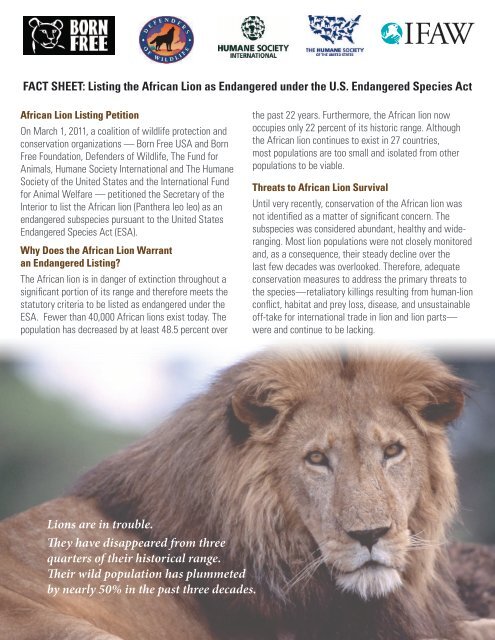Fact Sheet - International Fund for Animal Welfare
Fact Sheet - International Fund for Animal Welfare
Fact Sheet - International Fund for Animal Welfare
Create successful ePaper yourself
Turn your PDF publications into a flip-book with our unique Google optimized e-Paper software.
FACT SHEET: Listing the African Lion as Endangered under the U.S. Endangered Species Act<br />
African Lion Listing Petition<br />
On March 1, 2011, a coalition of wildlife protection and<br />
conservation organizations — Born Free USA and Born<br />
Free Foundation, Defenders of Wildlife, The <strong>Fund</strong> <strong>for</strong><br />
<strong>Animal</strong>s, Humane Society <strong>International</strong> and The Humane<br />
Society of the United States and the <strong>International</strong> <strong>Fund</strong><br />
<strong>for</strong> <strong>Animal</strong> <strong>Welfare</strong> — petitioned the Secretary of the<br />
Interior to list the African lion (Panthera leo leo) as an<br />
endangered subspecies pursuant to the United States<br />
Endangered Species Act (ESA).<br />
Why Does the African Lion Warrant<br />
an Endangered Listing?<br />
The African lion is in danger of extinction throughout a<br />
significant portion of its range and there<strong>for</strong>e meets the<br />
statutory criteria to be listed as endangered under the<br />
ESA. Fewer than 40,000 African lions exist today. The<br />
population has decreased by at least 48.5 percent over<br />
Lions are in trouble.<br />
They have disappeared from three<br />
quarters of their historical range.<br />
Their wild population has plummeted<br />
by nearly 50% in the past three decades.<br />
the past 22 years. Furthermore, the African lion now<br />
occupies only 22 percent of its historic range. Although<br />
the African lion continues to exist in 27 countries,<br />
most populations are too small and isolated from other<br />
populations to be viable.<br />
Threats to African Lion Survival<br />
Until very recently, conservation of the African lion was<br />
not identified as a matter of significant concern. The<br />
subspecies was considered abundant, healthy and wideranging.<br />
Most lion populations were not closely monitored<br />
and, as a consequence, their steady decline over the<br />
last few decades was overlooked. There<strong>for</strong>e, adequate<br />
conservation measures to address the primary threats to<br />
the species—retaliatory killings resulting from human-lion<br />
conflict, habitat and prey loss, disease, and unsustainable<br />
off-take <strong>for</strong> international trade in lion and lion parts—<br />
were and continue to be lacking.
Listing the African lion as endangered would be an essential step to<br />
reversing the current decline of this iconic species.<br />
<strong>International</strong> Trade in African Lions<br />
Of all these threats, the one that directly involves the<br />
United States and its citizens, and that can there<strong>for</strong>e be<br />
specifically addressed by an endangered listing under<br />
the ESA, is over-utilization <strong>for</strong> commercial or recreational<br />
purposes.<br />
The United States is the world’s largest importer<br />
of African lion parts, <strong>for</strong> hunting trophies and <strong>for</strong><br />
commercial purposes. Between 1999 and 2008, 7,090<br />
lion specimens, reported as being from a wild source,<br />
were traded internationally <strong>for</strong> recreational trophy<br />
hunting purposes, representing a minimum of 5,663<br />
lions. Most of these specimens were imported to the<br />
United States: 4,139 specimens, representing a minimum<br />
of 3,600 lions (64 percent of the total).<br />
Despite the significant and continuing population and<br />
range declines that this subspecies has suffered, the<br />
number of lion trophies imported to the United States is<br />
increasing: imports in 2008 were larger than any other<br />
year in the decade studied and more than twice the<br />
number in 1999. Over that decade, the United States<br />
imported lion specimens from at least twelve African<br />
countries where lion off-take was unsustainable.<br />
Similarly, but on a smaller scale, from 1999 to 2008,<br />
2,715 lion specimens, reported as being from a wild<br />
source, the equivalent of at least 1,043 lions, were<br />
traded internationally <strong>for</strong> commercial purposes. Of this<br />
trade, the United States imported 1,700 lion of the<br />
specimens (63 percent of the total), the equivalent of<br />
at least 362 lions (35 percent of the total). The most<br />
common lion specimens traded <strong>for</strong> commercial purposes<br />
were claws, trophies, skins, live animals, skulls and<br />
bodies.<br />
There is Hope: Protection through an<br />
Endangered Listing<br />
Listing the African lion as endangered would significantly<br />
benefit the iconic animal by generally prohibiting the<br />
importation to the United States of African lions and<br />
their parts, unless it serves a conservation purpose.<br />
Such a listing would be an essential step to reversing<br />
the current decline of the species. Moreover, such a<br />
listing would heighten awareness of the importance of<br />
African lion conservation among <strong>for</strong>eign governments,<br />
conservation organizations, and the general public.<br />
Africa’s lions need all the help they can get in order to<br />
ensure their long-term survival.<br />
www.bornfreeusa.org • www.humanesociety.org • www.hsi.org • www.defenders.org • www.ifaw.org

















